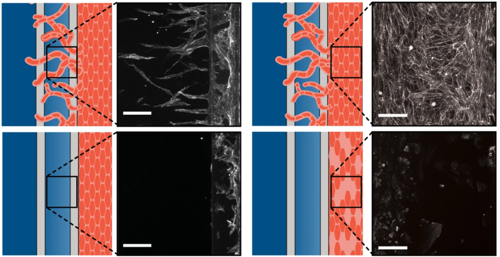Leiden, August 1, 2023 – MIMETAS researchers report the first large-scale phenotypic screen utilizing Organ-on-a-Chip (OoC) technology. The study, published in the Journal of Angiogenesis, marks a significant advancement in drug development, offering hope for more effective therapies and reducing the staggering costs and high failure rates associated with the process.
 Traditional drug development has been a complex and costly endeavor, with the trajectory of bringing a new drug to market typically spanning over a decade and costing billions of dollars. A major challenge has been the lack of comprehensive assays capable of identifying potential drug candidates with sufficient throughput in the early stages of research. This limitation has contributed to the high rate of clinical failures, particularly for chronic and prevalent diseases. OoC technology replicate human physiological processes by creating miniaturized cell cultures inside microfluidic chips. These chips mimic aspects such as perfusion flow, tissue architecture, mechanical strain, and precise control over gradients, making them ideal for high-throughput screening. However, high-throughput screening of thousands of compounds needed for phenotypic target or compound identification remains to be demonstrated.
Traditional drug development has been a complex and costly endeavor, with the trajectory of bringing a new drug to market typically spanning over a decade and costing billions of dollars. A major challenge has been the lack of comprehensive assays capable of identifying potential drug candidates with sufficient throughput in the early stages of research. This limitation has contributed to the high rate of clinical failures, particularly for chronic and prevalent diseases. OoC technology replicate human physiological processes by creating miniaturized cell cultures inside microfluidic chips. These chips mimic aspects such as perfusion flow, tissue architecture, mechanical strain, and precise control over gradients, making them ideal for high-throughput screening. However, high-throughput screening of thousands of compounds needed for phenotypic target or compound identification remains to be demonstrated.
To address this challenge, MIMETAS researchers successfully utilized OoC technology to screen a library of protein kinase inhibitors for their potential to inhibit angiogenesis—a process crucial for the formation of new blood vessels. Here, the team used an innovative plate format comprising 64 microfluidic chips underneath a standard microtiter plate. Over 4000 micro-vessels were grown under perfusion flow within the chips and subjected to a cocktail of pro-angiogenic factors. The scientists then exposed the micro-vessels to 1537 different protein kinase inhibitors, assessing the efficacy of compounds by their ability to reduce angiogenic sprouting. To ensure safety, they also evaluated the toxicity of the compounds by monitoring the integrity of the main micro-vessel.
The screen identified an impressive total of 53 hits: compounds demonstrating high anti-angiogenic potential combined with low toxicity. Notably, 44 of these hits had not previously been associated with angiogenic pathways, making them promising candidates for further investigation. This finding showcases the power of OoC models in efficiently screening large numbers of compounds to identify novel targets and potential first-in-class drugs for challenging diseases.
The successful implementation OoC technology in large-scale phenotypic screening opens new possibilities for the discovery of groundbreaking drugs. With improved decision-making throughout drug research and development, the chances of finding efficacious therapies are expected to rise, promising a brighter future for patients suffering from currently intractable diseases.
